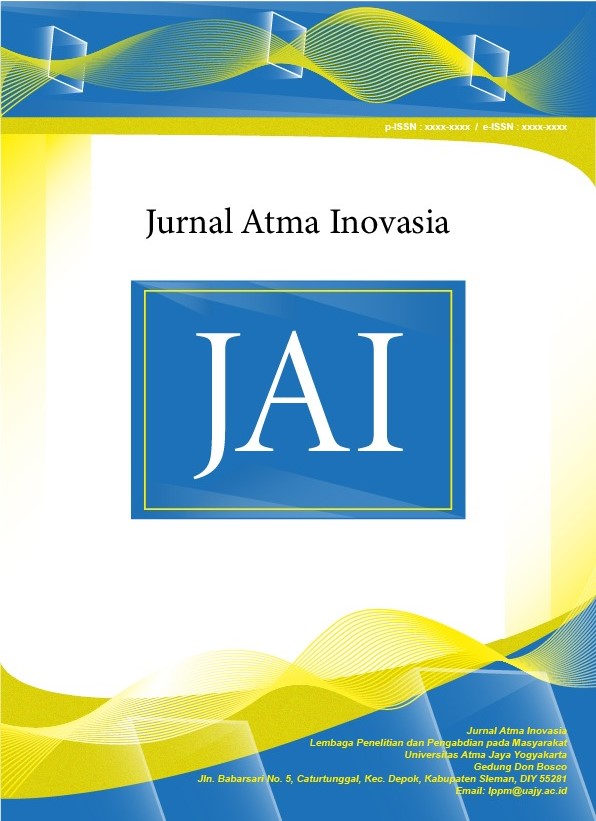Penataan Lingkungan Kantor Desa Caturharjo Kecamatan Pandak Kabupaten Bantul
DOI:
https://doi.org/10.24002/jai.v2i1.4967Keywords:
Desain, Fasilitas, Lingkungan, Desa CaturharjoAbstract
Desa Caturharjo mulai dikembangkan menjadi Kawasan Desa Wisata dengan membedayakan masyakarat secara terpadu. Desa wisata tersebut di kembangkan oleh pemerintah, sawsta dan masyarakat dengan melakukan secara gotong royong. Desa Caturharjo memiliki potensi yang dapat dikembangkan sebagai destinasi wisata. Pengabdian pada Masyarakat dilaksanakan bersama mitra berupa penataan desain lingkungan kantor desa Caturharjo yaitu penataan Kawasan alun-alun. Penataan Kawasan Alun-alun berkonsep pada arsitektur tropis. Hal ini dikarenakan desa Caturharjo yang berada di wilayah Daerah Istimewa Yogyakarta ingin tetap melestarikan material local dan pemanfaatan penghawaan alami dan pencahayaan alami untuk mengurangi penggunaan energi. Pengabdian yang dilakukan menggunakan metode pendekatan terhadap pihak desa dengan melakukan observasi, wawancara dan analisis. Analisis yang dilakukan adalah analisis SWOT terhadap fasilitas yang ada di desa Caturharjo. Analisis dilakukan untuk mengetahui kekuatan dan kelemahan dari desa tersebut. Hasil pengabdian masyarakat ini diharapkan dapat berupa desain penataan lapangan desa sebagai alun-alun desa. Pekarangan kemungkinan akan menjadi identitas caturharjo Desa. Masyarakat sekitar diharapkan dapat dimanfaatkan sebagai ruang publik. Hasilnya sarana penunjang yang terdiri dari kawasan kuliner, area duduk, area air mancur, gazebo, dan lapangan sepak bola mini.
References
P. K. Bantul, “Bantul Smart City,” Bantul, 2018.
C. Hernández Pezzi, Un vitruvio ecológico: principios y práctica del proyecto arquitectónico sostenible. Barcelona, 2012.
D. L. Jones, Arquitectura y entorno. El diseño de la construcción bioclimática. Barcelona: Art Blume, 2002.
M. Stiller, Quality lighting for high performance buildings. Lilburn: Fairmont Press, 2012.
T. Schröpfer, Ecological urban architecture: qualitative approaches to sustainability. Basel: Birkhauser Architecture, 2012.
R. Lopez, The built environment and public health. San Francisco: Jossey-Bass., 2012.
M. Alperytė, I., & Išoraitė, Developing a City Brand. Journal of Intercultural Management, 2020.
B. Talarosha, “Menciptakan Kenyamanan Thermal Dalam Bangunan,” J. Sist. Tek. Ind., vol. 6, no. 3, pp. 148–158, 2005.
D. D. Harisdani and F. Kartika, “Application of Tropical Architecture in Convention Hall Design,” Int. J. Archit. Urban., vol. 2, no. 3, pp. 263–274, 2018, doi: 10.32734/ijau.v2i3.658.
J. M. C. Lainez, “The quest for light in Indian architectural heritage,” J. Asian Archit. Build. Eng., vol. 7, no. 1, pp. 39–46, 2008, doi: 10.3130/jaabe.7.39.
P. Heiselberg, “Natural Ventilation Design,” Int. J. Vent., vol. 2, no. 4, pp. 295–312, 2004, doi: 10.1080/14733315.2004.11683674.
Dinas Pekerjaan Umum, “Rencana Detil Tata Ruang Kecamatan Pandak,” Bantul, 2014.
V. Trucks, V. Euro, S. C. R. Euro, N. Oxide, V. Table, and E. E. Regulations, “Fact sheet,” vol. 1, no. X, pp. 1–2, 2011.
“Tropical Architecture: The Art of Living in the Tropics.” https://indonesiadesign.com/story/tropical-architecture (accessed Apr. 16, 2021).
Pemerintah Daerah Istimewa Yogyakarta, “Arsitektur Berciri Daerah,” Yogyakarta, 2017.
S. Murakawa, T. Sekine, K. ichi Narita, and D. Nishina, “Study of the effects of a river on the thermal environment in an urban area,” Energy Build., vol. 16, no. 3–4, pp. 993–1001, 1991, doi: 10.1016/0378-7788(91)90094-j.
R. Sun and L. Chen, “How can urban water bodies be designed for climate adaptation?,” Landsc. Urban Plan., vol. 105, no. 1–2, pp. 27–33, 2012, doi: 10.1016/j.landurbplan.2011.11.018.
L. Yang, X. Liu, and F. Qian, “Research on water thermal effect on surrounding environment in summer,” Energy Build., vol. 207, p. 109613, 2020, doi: 10.1016/j.enbuild.2019.109613.
Kementerian Menteri Pekerjaan Umum, “Pedoman Penataan Vegetasi dan Perabot Jalan,” Jakarta, 2007.
M. Taleghani, “Outdoor thermal comfort by different heat mitigation strategies- A review,” Renew. Sustain. Energy Rev., vol. 81, no. March, pp. 2011–2018, 2018, doi: 10.1016/j.rser.2017.06.010.
M. Santamouris et al., “Passive and active cooling for the outdoor built environment – Analysis and assessment of the cooling potential of mitigation technologies using performance data from 220 large scale projects,” Sol. Energy, vol. 154, pp. 14–33, 2017, doi: 10.1016/j.solener.2016.12.006.
J. A. Salmond et al., “Health and climate related ecosystem services provided by street trees in the urban environment,” Environ. Heal. A Glob. Access Sci. Source, vol. 15, no. Suppl 1, 2016, doi: 10.1186/s12940-016-0103-6.
S. J. Livesley, E. G. McPherson, and C. Calfapietra, “The Urban Forest and Ecosystem Services: Impacts on Urban Water, Heat, and Pollution Cycles at the Tree, Street, and City Scale,” J. Environ. Qual., vol. 45, no. 1, pp. 119–124, 2016, doi: 10.2134/jeq2015.11.0567.
E. Jamei, P. Rajagopalan, M. Seyedmahmoudian, and Y. Jamei, “Review on the impact of urban geometry and pedestrian level greening on outdoor thermal comfort,” Renew. Sustain. Energy Rev., vol. 54, pp. 1002–1017, 2016, doi: 10.1016/j.rser.2015.10.104.
A. S. Nouri, J. P. Costa, M. Santamouris, and A. Matzarakis, “Approaches to outdoor thermal comfort thresholds through public space design: A review,” Atmosphere (Basel)., vol. 9, no. 3, 2018, doi: 10.3390/atmos9030108.
C. Gromke, B. Blocken, W. Janssen, B. Merema, T. van Hooff, and H. Timmermans, “CFD analysis of transpirational cooling by vegetation: Case study for specific meteorological conditions during a heat wave in Arnhem, Netherlands,” Build. Environ., vol. 83, pp. 11–26, 2015, doi: 10.1016/j.buildenv.2014.04.022.
R. Buccolieri, J. L. Santiago, E. Rivas, and B. Sanchez, “Review on urban tree modelling in CFD simulations: Aerodynamic, deposition and thermal effects,” Urban For. Urban Green., vol. 31, no. February, pp. 212–220, 2018, doi: 10.1016/j.ufug.2018.03.003.
Y. Yang, E. Gatto, Z. Gao, R. Buccolieri, T. E. Morakinyo, and H. Lan, “The ‘plant evaluation model’ for the assessment of the impact of vegetation on outdoor microclimate in the urban environment,” Build. Environ., vol. 159, no. May, 2019, doi: 10.1016/j.buildenv.2019.05.029.
K. R. Gunawardena, M. J. Wells, and T. Kershaw, “Utilising green and bluespace to mitigate urban heat island intensity,” Sci. Total Environ., vol. 584–585, pp. 1040–1055, 2017, doi: 10.1016/j.scitotenv.2017.01.158.
A. H. Radwan, A. Abdel, and G. Morsy, “The importance of integrating street furniture in the visual imageof the city,” vol. X, 2014.
C. R. Mourthé and J. B. De Menezes, “Ergonomics methodology for comparative study of street furniture in different cities,” Proc. XIVth Trienn. Congr. Int. Ergon. Assoc. 44th Annu. Meet. Hum. Factors Ergon. Assoc. ’Ergonomics New Millenn., pp. 28–31, 2000, doi: 10.1177/154193120004400807.
N. H. Ja’afar, A. B. Sulaiman, and S. Shamsuddin, “The Contribution of Landscape Features on Traditional Streets in Malaysia,” Procedia - Soc. Behav. Sci., vol. 50, no. July, pp. 643–656, 2012, doi: 10.1016/j.sbspro.2012.08.067.
N. Ujang, “Place Attachment and Continuity of Urban Place Identity,” Procedia - Soc. Behav. Sci., vol. 49, no. January, pp. 156–167, 2012, doi: 10.1016/j.sbspro.2012.07.014.
Y. Ye, T. Fei, and H. Mei, “The Relationship between Walkability and Environment Characteristics in Cold Region Cities: Case Study in Harbin,” IOP Conf. Ser. Earth Environ. Sci., vol. 63, no. 1, 2017, doi: 10.1088/1755-1315/63/1/012053.
N. Ginting, N. Vinky Rahman, A. Delianur Nasution, M. Nawawiy Loebis, and F. A. Sinaga, “Street furniture concept in Pasar Buah and Bukit Gundaling Based on place identity,” IOP Conf. Ser. Earth Environ. Sci., vol. 126, no. 1, 2018, doi: 10.1088/1755-1315/126/1/012195.
T. T. Amasuomo and G. Baird, “Evolution of buildings in four tropical regions with regards to thermal comfort Occupancy Evaluation of office environments View project Evolution of buildings in four tropical regions with regards to thermal comfort,” no. December 2016, pp. 617–626, 2016, [Online]. Available: https://www.researchgate.net/publication/316367220.
J. Campbell, “Islandness: Vulnerability and Resilience in Oceania,” Shima Int. J. Res. into Isl. Cult., vol. 3, no. 1, pp. 85–97, 2009.
Downloads
Published
Issue
Section
License
Copyright (c) 2022 Nimas Sekarlangit, Amos Setiadi, Riana Novita Rachmanti Putri

This work is licensed under a Creative Commons Attribution-ShareAlike 4.0 International License.










